
The common snapping turtle is a species of large freshwater turtle in the family Chelydridae. Its natural range extends from southeastern Canada, southwest to the edge of the Rocky Mountains, as far east as Nova Scotia and Florida. The present-day Chelydra serpentina population in the Middle Rio Grande suggests that the common snapping turtle has been present in this drainage since at least the seventeenth century and is likely native. The three species of Chelydra and the larger alligator snapping turtles are the only extant chelydrids, a family now restricted to the Americas. The common snapping turtle, as its name implies, is the most widespread.
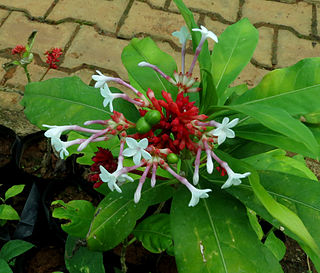
Rauvolfia serpentina, the Indian snakeroot, devil pepper, serpentine wood, Sarpagandha or Chandrika, is a species of flower in the milkweed family Apocynaceae. It is native to the Indian subcontinent and East Asia.
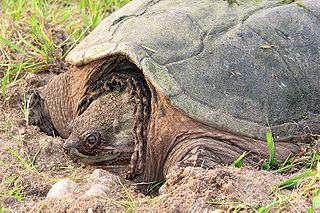
Chelydra is one of the two extant genera of the snapping turtle family, Chelydridae, the other being Macrochelys, the much larger alligator snapping turtle. The snapping turtles are native to the Americas, with Chelydra having three species, one in North America and two in Central America, one of which is also found in northwestern South America.

The putative hybrid cultivar Ulmus × hollandica 'Serpentina' is an elm of unknown provenance and doubtful status. Henry identified it as intermediate between U. glabra and U. minor, a view accepted by Bean and by Melville, who believed that the specimens at Kew bearing the name 'Serpentina' were U. glabra "introgressed by U. carpinifolia" [: U. minor] and were similar to but "distinct from 'Camperdownii'".

Marmorana is a genus of air-breathing land snails, terrestrial pulmonate gastropod mollusks in the subfamily Murellinae of the family Helicidae.

Marmorana serpentina is a species of air-breathing land snail, a terrestrial pulmonate gastropod mollusc in the family Helicidae.
Chelydrops is an extinct genus of Chelydridae from Miocene of North America. Only one species is described, Chelydrops stricta.
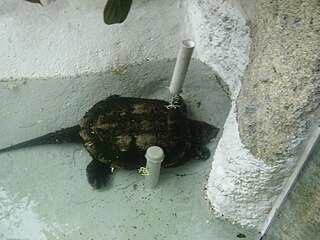
The South American snapping turtle is a species of turtle in the family Chelydridae. This species, which is endemic to Central and northwestern South America, was previously considered a subspecies of Chelydra serpentina. Its restricted range in South America reflects its recent arrival there as part of the Great American Interchange.

Callyspongia (Cladochalina) aculeata, commonly known as the branching vase sponge is a species of sea sponge in the family Callyspongiidae. Poriferans are typically characterized by ostia, pores that filter out plankton, with an osculum as the opening which water leaves through, and choanocytes trap food particles.
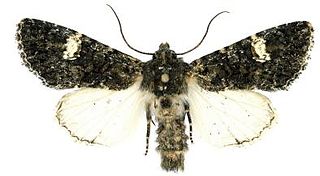
Polymixis serpentina is a moth of the family Noctuidae. It is found in Italy, the Balkan Peninsula and Crete.

Polymixis iatnana is a moth of the family Noctuidae. It is found on Cyprus.

Callyspongia truncata is a species of marine sea sponge. Like all marine sponges, C. truncata is a member of phylum Porifera and is defined by its filter-feeding lifestyle and flagellated choanocytes, or collar cells, that allow for water movement and feeding. It is a species of demosponge and a member of Demospongiae, the largest class of sponges as well as the family Callyspongiidae. C. truncata is most well known for being the organism from which the polyketide Callystatin A was identified. Callystatin A is a polyketide natural product from the leptomycin family of antibiotics. It was first isolated in 1997 from this organism, which was collected from the Goto Islands in the Nagasaki Prefecture of Japan by the Kobayashi group. Recent studies have revealed numerous other bioactive compounds that have been found in this species.
Callyspongia (Cladochalina) johannesthielei is a species of demosponge in the family Callyspongiidae. It is found in Indonesia.

Callyspongia crassa, commonly known as prickly tube-sponge, is a species of sponge found from the Red Sea to the Seychelles. Its wide flexible brown tube with exterior protuberances can appear as a single tube or as clusters of tubes and can reach up to 50 centimeters in size. Like many other sea sponges, it is primarily used for marine drugs as they have many bioactive components and properties. They also play an important role in marine reef and benthic communities, as they constantly filter water and act as habitats for smaller organisms. As sea sponges, they have the ability to reproduce both sexually and asexually.
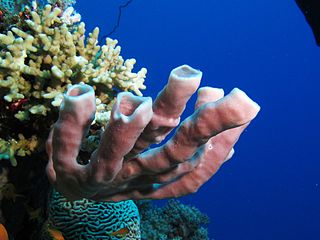
Callyspongia siphonella, commonly known as colonial tube-sponge, is a species of sea sponge endemic to the Red Sea. Clusters of its pale lavender to pink long tubes reach up to 60 centimetres (24 in) in size. Callyspongia siphonella contains a bioactive compound, Sipholenol A., that has been studied for its anti-proliferative properties in human breast cancer; these properties provide promise in its potential for developing future compounds and thus contributes greatly to future cancer research.

Melaleuca serpentina is a plant in the myrtle family, Myrtaceae and is endemic to the Barraba district in Australia. It is a shrub with yellow or creamy-green bottlebrush flowers. It is similar to Melaleuca citrina but can be distinguished from that species by its flower colour and its shorter stamens.
Jorunna spongiosa is a species of sea slug, a dorid nudibranch, a shell-less marine gastropod mollusc in the family Discodorididae.

Callyspongia plicifera, the azure vase sponge, is a species of sea sponge belonging to the family Callyspongiidae. It is native to the Bahamas where it is found at a depth of 31.5-44.2 m. It was first described in 1814 by Jean-Baptiste Lamarck.
Callyspongia elegans is a species of demosponge in the genus Callyspongia.

Calligrapha serpentina, the globemallow leaf beetle, is a species of leaf beetle in the family Chrysomelidae. It is found in Mexico and the United States.















